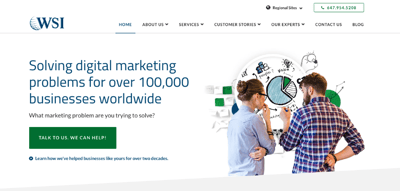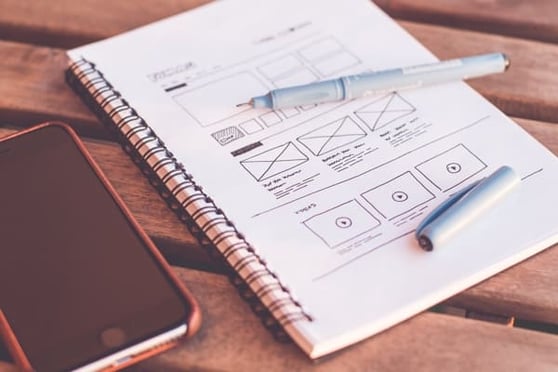Just in case you were wondering, UX and website design iteration are crucial. The saying "If it ain't broke, don't fix it" shouldn't be applied to your website design.
Here's why: your website essentially begins to break when you launch it. It's like driving a new car off the lot – the second you hit the highway, the car loses 20% of its value.
This isn't a pessimistic take or anything like that; it's simply the state of doing business in our increasingly digital world. Tactics, design trends, and, most significantly, usability testing requirements dictate the importance of iterating your website and improving its usability as frequently as possible.
Benefits of Iterative Design
Iterative design is a game-changer for UX and website design—and if you’re not using it, you’re missing out. It’s all about constant improvement through testing and evaluating, user feedback, and tweaking, which means you’re never stuck with a “finished” product that’s outdated the moment it launches. Instead, you’re continuously refining and improving the user interface and interaction design, ensuring every click, scroll, and interaction feels natural and intuitive.
This approach leads to happier users, higher conversions, and fewer costly redesigns. Why gamble on a one-shot development and design process when you can quickly create and test ideas using an iterative feedback-based model? Iterative development keeps you ahead of the curve, not catching up to it.
Based on our experience redesigning and migrating the WSIWorld website, let’s consider why regularly iterating your website's design and UX is so important.
The Digital World Moves Fast
Perhaps the biggest reason not to let your website's design and UX stagnate is the speed at which the digital landscape moves. We do business in a world that changes fast – faster than most of us can even keep up with – and with that comes the need to quickly adapt users' efficiency, strategies, and tools. What worked in the digital world two years ago probably doesn't work the same today. So, as good as your website looked and functioned two years ago, it's old for all proportions of users in today's digital world.
Practice What You Preach
For us, redesigning our website and its UX is part of a business goal dedicated to "practicing what we preach" or "drinking our own champagne." We say that we help businesses do better marketing, and to do that, we need to have our own ducks in a row. As we've discussed, in 2019 and beyond, it's important to iterate your website's design and UX regularly. So that's what we've done: we've completely revamped our website and UX. We're proud of the new site, so please look around and let us know what you think!
Follow The Numbers
In the digital marketing world, numbers and data are hugely important. As soon as you visit any website, you also begin collecting data. And unless you've somehow built the perfect website, that data will immediately point to specific mistakes or areas where your site isn't working optimally. Whether that's because users behave differently than you thought or a design element isn't as engaging as you hoped, it doesn't matter. Once your site has been live for a few months, dig into the data, and you'll quickly have a list of things to work on for the site's following iterative design process.
Optimize Your Website Design
Sometimes, you just can't see the finished product until a project is launched. This is part of why we'd rather ship something imperfect and iterate rather than wait for perfection, but that's a post for another day.

While creating the new WSIWorld, we followed the following website optimization strategies:
- Analyzed data on our legacy website,
- Considered modern design and UX trends,
- Audited our content and SEO strategy,
- Really honed in on our customer personas.
As a result, here are some rules of thumb we came up with, which you can use if you're thinking about a website redesign.
Don't Make Your Visitors Think
Giving your website visitors too many things to think about or too many places to look or click causes cognitive friction. So, when users are overwhelmed by a design decision on a website, what do they most often do? Click back and try something else – otherwise known as a bounce.
This is why, on the homepage of your website – above the fold – you should try to tell your website visitors:
- Who you are,
- What you do,
- Why they should trust you.
While it might seem challenging to do all of this in such a small space, it's a major goal to put the time and effort into optimizing this information.
Avoid "Greedy Marketer Syndrome"
Picture this: You've got a new website, and you're excited. You want to reap the benefits of all that hard work as soon as possible. So you launch the site and can't wait to get that first conversion. Sound familiar?
As tough as it is, we recommend avoiding "greedy marketer syndrome." The fact is, we shouldn't really want or expect our website visitors to take the bottom-of-the-funnel conversion action right away. Instead, we should earn their trust and allow them to make decisions without being overly pushy.
This is why, for example, we chose to go with "Talk To Us. We Can Help." as our main CTA button text instead of "Book A Consultation Now!"
Conduct Post-Launch Analysis
We'll close this post by reminding you not to forget to conduct a user experience analysis once you've rolled out the new site and UX. There will be immediate data, so why not use it? Heatmaps and A/B tests can give you insight into how users are engaging and what they're clicking on – maybe you can even make some improvements in usability to your website design right away.
Common Website Design Mistakes to Avoid
Some common website design mistakes include poor navigation, which makes it difficult for users to find information, and slow loading speeds that drive visitors away. Ensuring a site is mobile-friendly is another issue, as more users access websites on mobile devices. Other mistakes include poor readability due to low-contrast text, a lack of clear calls to action, and an overcrowded design that overwhelms users. Ignoring SEO and accessibility can limit your site’s visibility and exclude users with disabilities. Additionally, neglecting to update content regularly, using too many pop-ups or ads, and failing to analyze user data can all hinder the effectiveness of a website. Addressing these issues through a systematic iterative process ensures the site is user-friendly, optimized, and effectively meeting business goals.
Importance of Usability Testing
Usability testing is a critical component of the UX design process, helping ensure that a website or product meets users' needs and expectations. By testing a site or application's usability, designers can identify potential issues hindering user experience before the final product is launched. The importance of usability testing lies in its ability to provide real-world feedback, guiding design adjustments and improvements.
Key Reasons for Usability Testing:
- Identifies User Pain Points: Usability testing reveals where users struggle, allowing designers to address navigation or functional issues early in the process.
- Enhances User Satisfaction: Testing helps ensure the final design is intuitive and easy to use, leading to better user engagement and overall satisfaction.
- Increases Conversion Rates: By improving the usability of a site, businesses can increase conversion rates, as users are more likely to complete desired actions (e.g., signing up, purchasing).
- Reduces Development Costs: Catching usability issues during testing can prevent costly redesigns or changes later in the development process.
- Validates Design Decisions: User feedback provides data-driven insights that can confirm or challenge design assumptions, ensuring the final product aligns with user needs.
Incorporating usability testing into the design cycle allows for a more efficient, user-centered approach. This leads to a better user experience and a product that aligns with the goals of both the business and the end-user.
How AI Enhances the Iterative Design Process
AI is transforming the iterative design approach by streamlining workflows, improving UX design, and adapting to evolving user needs. It enables designers and developers to identify bottlenecks quickly, make necessary changes, and ensure every iteration improves aesthetics and functionality. Here's how AI adds value to the iterative development process:
- Real-Time User Insights: AI-powered tools, such as heatmaps and behavior analytics, identify where users encounter difficulties, allowing for timely modification of the UI.
- Enhanced User Research: AI analyzes vast data sets to segment audiences, predict behavior, and tailor designs to meet specific user needs and expectations.
- Automated Testing: AI facilitates repeatedly testing prototypes through A/B tests and simulations, accelerating the trial and error while delivering actionable feedback.
- Adapting to New Requirements: With its predictive capabilities, AI ensures that designs evolve with changing technical requirements and market trends.
By incorporating AI into the development lifecycle, teams can deliver cost-effective solutions that satisfy stakeholders and create a final product optimized for users.
Partner with WSI to Optimize Your Website Design
Ready to take your website to the next level? Partner with us at WSI, a leading digital marketing agency, to implement an iterative approach that drives continuous improvement throughout development. Our development team uses agile methodologies and follows a systematic, iterative cycle to refine your interface design with optimization in mind. We start with initial planning, ensuring each phase aligns with your objective and user needs.
Good luck, and be sure to reach out if you have any questions on UX and website design iteration!






